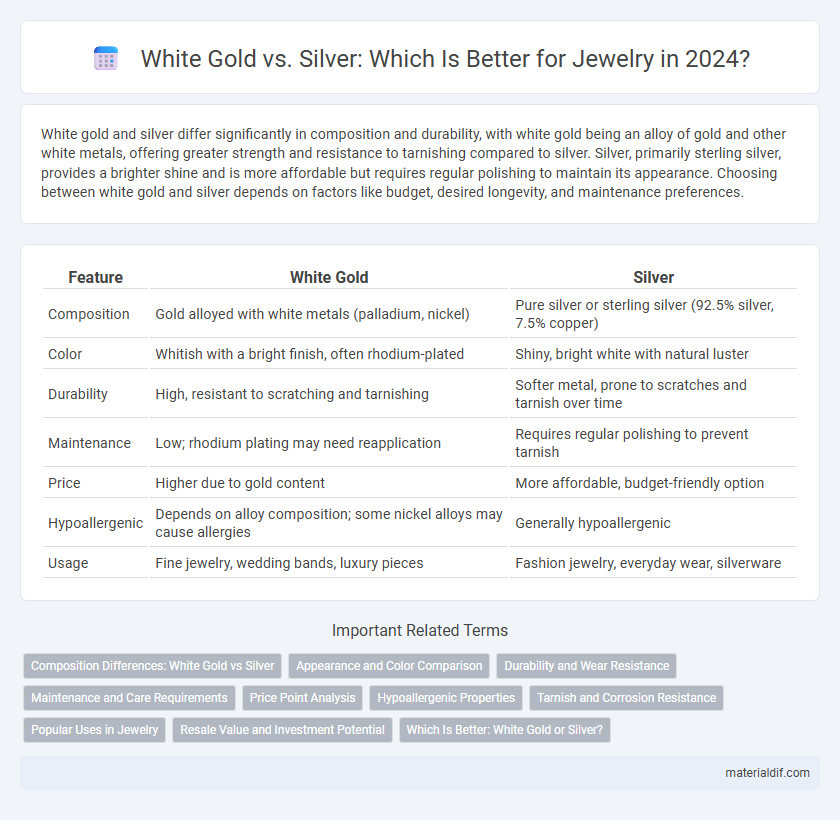White gold and silver differ significantly in composition and durability, with white gold being an alloy of gold and other white metals, offering greater strength and resistance to tarnishing compared to silver. Silver, primarily sterling silver, provides a brighter shine and is more affordable but requires regular polishing to maintain its appearance. Choosing between white gold and silver depends on factors like budget, desired longevity, and maintenance preferences.
Table of Comparison
| Feature | White Gold | Silver |
|---|---|---|
| Composition | Gold alloyed with white metals (palladium, nickel) | Pure silver or sterling silver (92.5% silver, 7.5% copper) |
| Color | Whitish with a bright finish, often rhodium-plated | Shiny, bright white with natural luster |
| Durability | High, resistant to scratching and tarnishing | Softer metal, prone to scratches and tarnish over time |
| Maintenance | Low; rhodium plating may need reapplication | Requires regular polishing to prevent tarnish |
| Price | Higher due to gold content | More affordable, budget-friendly option |
| Hypoallergenic | Depends on alloy composition; some nickel alloys may cause allergies | Generally hypoallergenic |
| Usage | Fine jewelry, wedding bands, luxury pieces | Fashion jewelry, everyday wear, silverware |
Composition Differences: White Gold vs Silver
White gold is an alloy primarily composed of pure gold mixed with white metals such as palladium, nickel, or manganese to achieve its silvery appearance, while silver is a naturally occurring element often used in its sterling form, which consists of 92.5% pure silver and 7.5% other metals, usually copper. The combination of metals in white gold provides greater hardness and durability compared to the softer and more malleable nature of silver. White gold's composition also affects its color, giving it a slightly warmer tone than the bright, reflective white sheen of pure or sterling silver.
Appearance and Color Comparison
White gold exhibits a slightly warmer, yellowish sheen compared to silver's bright, shiny, and cooler white tone. Silver tends to develop a natural tarnish over time, resulting in a darker patina, whereas white gold maintains its lustrous finish due to rhodium plating. The subtle difference in color undertones makes silver appear more reflective and brilliant, while white gold offers a more muted and sophisticated elegance.
Durability and Wear Resistance
White gold offers superior durability and wear resistance compared to silver, making it less prone to scratches and tarnishing over time. While silver is softer and more susceptible to dents and oxidation, white gold's alloy composition enhances its strength and longevity. This makes white gold a preferred choice for jewelry that is worn daily or subjected to frequent contact.
Maintenance and Care Requirements
White gold requires regular rhodium plating to maintain its bright, reflective finish and prevent yellowing, while silver tarnishes over time due to exposure to air and moisture, necessitating frequent polishing. Silver is more prone to scratches and oxidation, so storing it in anti-tarnish cloths or airtight containers helps reduce maintenance. Both metals benefit from gentle cleaning with appropriate solutions, but silver's upkeep typically demands more consistent attention to preserve its appearance.
Price Point Analysis
White gold generally commands a higher price point than silver due to its gold content and alloy composition, which enhances durability and maintains a luxurious appeal. Silver is more affordable and accessible, making it a popular choice for budget-conscious buyers seeking a similar aesthetic. Market fluctuations in precious metal prices and craftsmanship quality further influence the cost disparity between white gold and silver jewelry.
Hypoallergenic Properties
White gold and silver both serve as popular choices in hypoallergenic jewelry, but white gold typically undergoes an alloying process that can introduce nickel, a common allergen, whereas silver, especially sterling silver with a 92.5% purity, generally poses fewer allergy risks. Nickel-free white gold options are available and can be suitable for sensitive skin, though silver remains favored for its natural hypoallergenic properties and lower likelihood of causing skin reactions. Choosing between white gold and silver should consider individual sensitivities and the specific metal composition to ensure hypoallergenic benefits.
Tarnish and Corrosion Resistance
White gold exhibits superior tarnish resistance compared to silver due to its alloy composition that often includes palladium or nickel, which prevents oxidation and corrosion. Silver, particularly sterling silver, is prone to tarnishing when exposed to sulfur compounds in the air, forming a dark patina over time. Corrosion resistance in white gold is generally higher, making it a more durable choice for jewelry that maintains its luster without frequent polishing.
Popular Uses in Jewelry
White gold and silver are both popular choices in jewelry due to their lustrous appearance and versatility. White gold, often alloyed with palladium or nickel, is favored for engagement rings and fine jewelry because of its durability and resistance to tarnish. Silver, prized for its affordability and bright shine, is commonly used in fashion jewelry and intricate designs but requires regular polishing to maintain its appearance.
Resale Value and Investment Potential
White gold typically holds a higher resale value than silver due to its rarity and alloy composition, making it more attractive for investment purposes. Silver's market price is more volatile and generally lower per ounce, which can impact its long-term investment potential compared to white gold. Investors often prefer white gold for jewelry and assets because it combines aesthetic appeal with greater durability and stability in value.
Which Is Better: White Gold or Silver?
White gold offers superior durability and resistance to tarnish compared to silver, making it a better choice for long-lasting jewelry. Silver boasts a bright, natural luster and is more affordable, appealing to those seeking budget-friendly options. In terms of maintenance, white gold requires less frequent polishing, while silver needs regular cleaning to maintain its shine.
White Gold vs Silver Infographic

 materialdif.com
materialdif.com